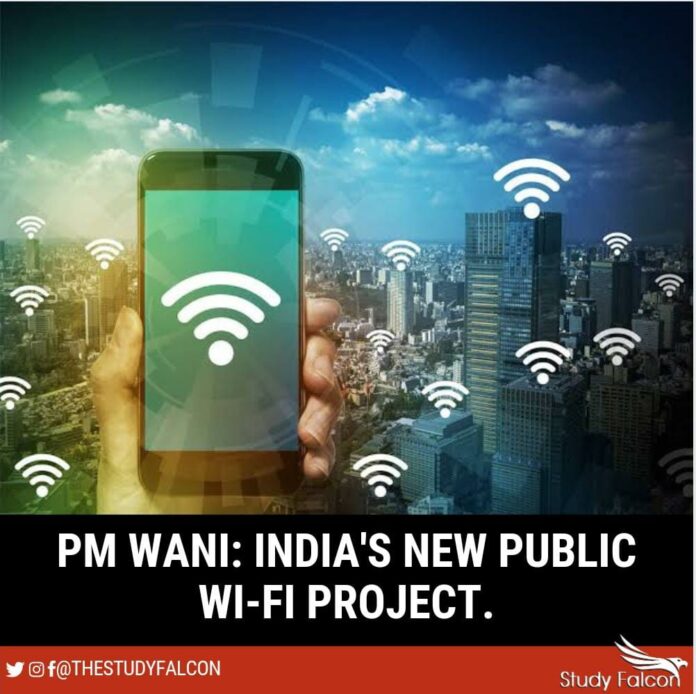The Union Cabinet recently sanctioned a proposal by the Department of Telecommunications (DoT) to set up public Wi-Fi access network interfaces. The public Wi-Fi Access Network Interface, which will be called ‘PM-WANI’, was first recommended by the Telecom Regulatory Authority of India (TRAI) in 2017.
PM-WANI will involve multiple players, including Public Data Officer (PDOs) , PDO Aggregator PDOAs, app providers, and a central registry. PM-WANI infrastructure can be structured in the form of a pyramid.
In this pyramid on top lies Central Registry which is maintained by the Centre for Development of Telematics. Next in line are App providers for development of apps for users. Then is PDOA’s perform the functions relating to authorisation and accounting. Then comes PDO this will establish, maintain, and operate complaints and WiFi access points or routers. And deliver broadband services to subscribers.
There is a Need for a Public Wi-Fi Network in India to increase the proliferation of internet services in the country. With PDOs – which will basically be small retail outlets across the length and breadth of the country – last mile connectivity is being aimed at. Also to offer a cost-effective option for the common man. Even in urban areas with sufficient mobile data coverage, the mobile internet tariffs are bound to increase.
This move is a step towards achieve the ‘Digital India’ vision. From 2015 to June of 2020, India grew from 302 million internet subscribers to 750 million. That is a Compound Annual Growth Rate (CAGR) of 20%, making India one of the fastest growing internet markets in the world. However, this statistic overshadows the quality of access. Only 23 million are wired internet subscribers.
If Digital India vision is to be achieved, there is a need to deliver a resilient and reliable connection to every Indian, so that they can have reliable access everywhere, at affordable price points. According to Digital Quality of Life Index 2020, India was placed at 9th position in Internet Affordability, outperforming even countries like the UK, the USA and China. While, for Internet Quality and E-infrastructure, India was almost at the bottom of the pillar placed at 78th and 79th (out of 85) positions respectively.
This scheme, PM WANI has the following benefits-
- It has the potential to generate over 2 crore jobs and entrepreneurship opportunities, besides offering a cost-effective means of mass connectivity.
- Given the National Digital Communications Policy goals of creating 1 crore public Wi-Fi hotspots by 2022, and with the present number being merely at 3.5 lakh, PM-WANI is expected to result in the creation of demand and scope for developing the components for this pan-India activity (Atmanirbhar Bharat).
- PDOs can become local distribution centres for content. Students in rural areas can access offline content without using bandwidth. Combining this with the liberalisation of the Other Service Providers (OSPs) regulations, one can see that India is paving the way for digital
- SMEs (Small and Medium-sized Enterprises) to go online without the burden of onerous compliances. It will further ease of doing Business and Ease of Living, as it will enable small shopkeepers to provide Wi-Fi service.
There are various challenges in execution of this scheme one of them is Network Security as most Wi-Fi hotspots don’t encrypt information that is sent over the Internet and therefore aren’t secure. This could potentially lead to hacking or unapproved access to personal information on the device.
However, the Indian public Wi-Fi hotspot network envisages that the access to the Internet through these points will be permitted only through electronic KYC (Know Your Customer) and a mix of OTP (One-Time Password) and MAC ID-based authentication system, thereby minimising the risk of network security being compromised. The MAC authentication method grants access to a secure network by authenticating devices for access to the network.
The viability of public Wi-Fi networks in India has also been called into question with several tech-giants already having tried and failed. In 2017, social media company Facebook had launched Express Wi-Fi. The project made little impact. Google’s Station project, to provide free wi-fi in more than 400 railway stations across India and “thousands” of other public places, which was launched in 2015, was shut down earlier this year. Google cited cheaper and more accessible mobile data, government initiatives to provide access to the Internet for everyone and the challenge of varying technical requirements and infrastructure.










